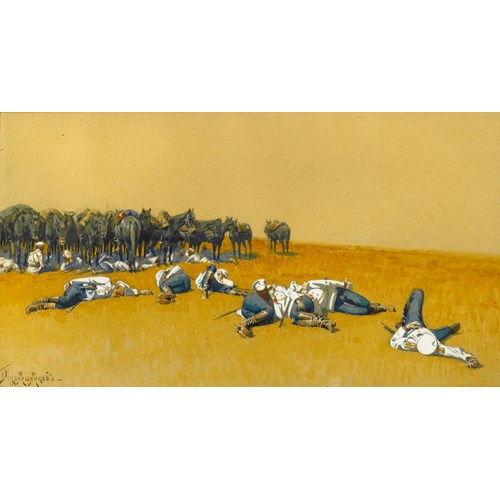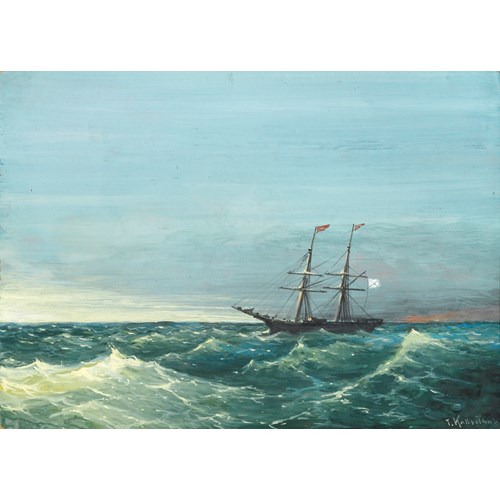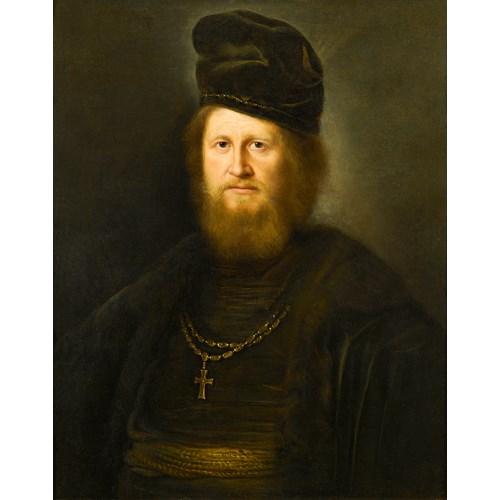Coenraet Roepel
Still Life of Grapes, Melons, Peaches, Plums and other Fruit with Morning Glory and Shafts of Wheat in a Stone Niche, with a Bunch of Grapes and Medlars Hanging Above
Period 1600-1750, 18th century
Origin The Netherlands
Medium Oil on canvas
Dimension 85.1 x 57.8 cm (33¹/₂ x 22³/₄ inches)
In the upper portion of the present painting, a lusciously heavy bunch of grapes is suspended with a gold ring from the top of the arched niche. Hanging with the grapes are medlars and carnations. Below, on the stone ledge, sit a profusion of ripe fruit including melons, peaches, plums, a pomegranate and green grapes. A trail of Morning Glory and a few shafts of wheat are interspersed with the fruit, and various insects feast from the abundance on display. A snail sits on one of the melons, a caterpillar inches along the Morning Glory, a butterfly hovers near the carnations and a spider lowers itself from the bunch of medlars. Although the pictorial representation is artificial, in that it brings together fruit and flowers that would never be found side by side in nature, there is exceptional realism in the way that each detail is depicted. Roepel’s mastery of light effects and his skill in portraying reflections on each piece of the variously textured fruit is exceptional. His ability to capture the beauty of nature and preserve it through mimesis is a defining characteristic of Dutch still lifes and is highly evident in Roepel’s work.
The arched niche framing the still life is a clever artistic device designed to deceive the eye into seeing an actual architectural feature. Roepel’s use of shadowing and perspective gives the impression that the fruit is suspended from or positioned in a recessed space. In addition, the niche, according to Mariët Westermann, evokes ‘a long tradition of devotional images, in which an isolated Madonna and Child or saint would invite viewers to meditation. Such imagery was no longer viable in Protestant cultures, but this particular mode of looking may well have survived’.¹ The still life, therefore, is designed for contemplation, both on an aesthetic level, in which the viewer appreciates the symmetry and veracity of the composition, and on a deeper spiritual level in which the choice of fruit and flowers is endowed with a symbolic significance.
What becomes most evident when examining the present work, apart from its striking attention to detail, is the overly ripe state of most of the fruit. One of the melons has burst open, revealing its seeds and soft sweet flesh. Dew drops linger on the surfaces of the melons, peaches, apricots and plums. Small holes have been bitten out of most of the pieces of fruit and a large chunk of the pomegranate has been removed, scattering its juicy red seeds. Many of the grapes appear soft and exude liquid. The plums beside them have been nibbled away by insects. One of the carnations hanging overhead has already fully bloomed and its petals are beginning to droop. The leaves of the medlars are not only chewed up but are turning brown.
The over ripeness of the fruit, their blemishes and signs of decay are indicators that Roepel’s still life is not simply a celebration of nature’s abundance but a reminder of the transience of life. The painting has a dual message, encouraging viewers to appreciate the beauty around them but simultaneously remember that it is short lived. For a seventeenth-century Dutch audience, reconciling the wealth of the republic with strict Calvinist morals could be problematic and a still life such as this illustrated this dilemma, both presenting an image of luxury and calling for moderation. The fruit that is beginning to rot, although not as obvious a vanitas symbol as a skull or an hourglass, is a reference to mortality and to the fragility of earthly pleasures. The dewdrops and insects gathering on the fruit are further representations of the fleeting nature of life. The morning glory is a particularly ephemeral flower, as it blooms in the morning and dies by the evening.
The choice of fruit displayed in Still Life of Grapes, Melons, Peaches, Plums and other Fruit with Morning Glory and Shafts of Wheat in a Stone Niche, with a Bunch of Grapes and Medlars Hanging Above is as significant as the way in which it is portrayed. The medlars are perhaps the most evocative of the fruit as they have unusual properties and would have had clear associations to contemporary viewers. Medlars require bletting to make them edible, a process that involves letting them decay and ferment for several weeks. After bletting, the skin rapidly becomes wrinkled and turns dark brown. This aspect of physical decay made the medlar a common literary metaphor, particularly in the sixteenth and seventeenth centuries, when medlars were often likened to human nature. In Shakespeare’s As You Like It, Rosalind compares her interlocutor to a medlar tree, saying, ‘for you’ll be rotten ere you be half ripe’ (III.ii.118). In the early Jacobean comedy, The Honest Whore, Thomas Dekker writes, ‘I scarce know her, for the beauty of her cheek hath, like the moon, suffered strange eclipses since I beheld it: women are like medlars - no sooner ripe but rotten’ (I.i.98).
Although the significance ascribed to types of fruit varies from source to source, an overarching religious theme in Roepel’s selection can be traced. A most obvious metaphor is in the grapes and shafts of wheat that traditionally represent the blood and body of Christ. The carnation is known as the ‘flower of God’, signifying pure love, and in representations of the Virgin and Child, it is often a token offered by Mary to her son. The pomegranate, which has had multiple religious and metaphorical meanings throughout history, represents resurrection in the Christian faith, and also figures in a number of images of the Virgin and Child. The fruit, broken or bursting open, as in the present painting, is sometimes viewed as a symbol of the fullness of Christ’s suffering and resurrection. The butterfly is similarly a symbol of resurrection and transformation. The religious message of the painting, therefore, could be interpreted as an uplifting one, suggesting the promise of life after death.
A still life painting of fruit by Roepel in the Rijksmuseum, Amsterdam, is striking both in its similarities and its contrasts with the present work. A dark and beautifully luminous bunch of grapes intertwined with a medlar hangs in an identical fashion to the present painting, with the addition of a sprig of cherries. A melon, this time unopened, sits on the ledge, accompanied by grapes, peaches and different varieties of plums and small blossoming flowers. A bronze statue of a putto is nestled amongst the fruit, holding aloft a shell, on which sits a shiny nectarine. A fly buzzes near one of the peaches, a caterpillar eats its way through a leaf and two moths hover nearby; there are, however, fewer insects visible than in the present work. With the exception of a crushed grape and two split plums, the fruit is intact and there are no signs of its flesh spilling onto the stone ledge. Although both still lifes incorporate fruit and flowers that have been picked and are therefore dying, in the Rijkmuseum composition they are depicted before the signs of decay are rife. The mood of the painting, therefore, seems to be more a joyous celebration of the bountiful gifts of nature, directly referenced in the bronze putto’s gesture of offering, than a moralistic chiding. Although there are subtle visual indications that the abundance will be short lived, and references to temporality, such as the dew drops and insects, one is not immediately aware of them, as in the present painting.
The extent of Roepel’s virtuosity in depicting flowers as well as fruit is revealed in another still life painting in the Rijksmuseum, which like the previous example shows an image of nature suspended between life and death. Like the fruit, the flowers are not growing as nature intended but have been plucked and gathered in an artificial bouquet. They have not progressed to a rapid state of physical decay, yet many of the blossoms are beginning to show signs of wilting. A full and heavy headed peony droops to the point of almost touching the stone ledge on which the vase sits. The stem of one of the pale pink roses has snapped and the blossom dangles off the ledge. These falling flowers are not only a means of displaying Roepel’s talent for depicting the contrast between their soft velvety petals and the rough hardness of the stone, but bring to mind the transience of life, as do the insects that menacingly creep around ready to feast on the leaves and petals. The flowers on display are plentiful in variety and riotous in colour, evoking luxury, particularly in the inclusion of the rare and coveted tulip. Besides their aesthetic appeal and economic value, the choice of flowers, like the choice of fruit in the present work, no doubt has a rich symbolism, both religious and secular.
Roepel was a pupil of the portrait and genre painter Constantijn Netscher (1668-1723), whose influence can be discerned in the architectural elements and sculptures contained in his still lifes. Roepel was an avid gardener, which may explain his passion for painting fruit and flowers and his skill in portraying them with such detail and naturalism. The high quality and finish of his works attracted an international clientele, even though Roepel never left The Hague, apart from a brief stay in Germany. His patrons included the Elector Palatine in Düsseldorf, Lord Cadogan, Prince Williiam of Hessen and other members of the nobility. He also collaborated with Matthias Twerwesten (1670-1757), painting wall decorations in The Hague, some of which have survived. In 1718, he was inscribed in the Confrerie Pictura, eventually becoming deacon of the board. Johan van Gool, the painter and biographer, devoted eight pages of his book to Roepel and described him as sought after and well paid. He also mentions that the artist’s patrons let him paint their own flowers.² Evidence from eighteenth-century collections and sale catalogues suggests that Roepel’s works were held in high esteem and copied by his contemporaries.
We are grateful to Fred Meijer of the Rijksbureau voor Kunsthistorische Documentatie, The Hague, for endorsing the attribution to Roepel, based on photographs.
¹ M. Westermann, The Art of the Dutch Republic 1585-1718, The Orion Publishing Group, London 1996, p. 90.
² Johan Van Gool, De Nieuwe Schouburg der Nederlantsche kunstschilders en schilderessen: Waer in de Levens- en Kunstbedryven der tans levende en reets overleedene Schilders, die van Houbraken, noch eenig ander schryver, zyn aengeteekend, verhaelt worden, The Hague, (privately printed), 1750-1751.
Period: 1600-1750, 18th century
Origin: The Netherlands
Medium: Oil on canvas
Dimension: 85.1 x 57.8 cm (33¹/₂ x 22³/₄ inches)
Provenance: Brig. Sir Geoffrey Hardy-Roberts;
By whom sold, London, Sotheby's, July 10, 1974, lot 23 (as by Cornelis de Heem);
Oppenheimer, Malmö, Sweden, 1986;
With Kunsthandel K. & V. Waterman, Amsterdam, by 1986, from whom acquired in 1990 by the previous collector.
More artworks from the Gallery









